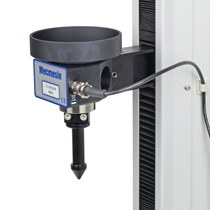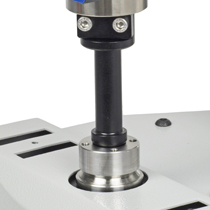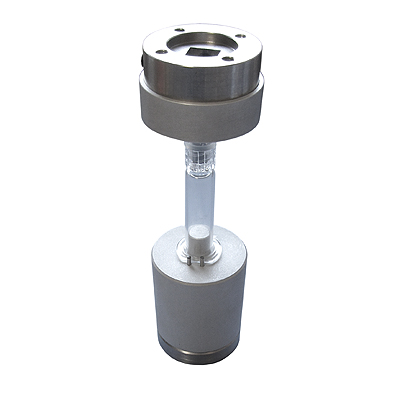
The 6% taper Luer lock-type of fitting (screw or lug) for syringes, needles and other medical devices has the primary purpose of ensuring a leak-free connection in delivering fluids. For systems using semi-rigid materials (e.g. plastics), the relevant standards require a specific metal conical reference fitting to be used, either male or female, to test both parts of the connector, ensuring control over dimensions and tolerances. A test system which is able to accurately apply a top-load axial force is required (27.5 N), with the simultaneous application of a very small torque value of 0.12 N.m. There are additional considerations in the design of an automated, purpose-built, test system for these standards, which are validating that the fastening torque is satisfactory to achieve the seal. Namely, the provision to supply the fluid to the Luer component and to a stipulated pressure for the liquid leakage standard, or to draw fluid into a syringe to a percentage of its capacity for the air leakage during aspiration (filling) test. The testing for liquid leakage requires the application of an effective internal water pressure of between 300 kPa and 330 kPa once assembled to the reference fitting. Visible inspection for leakage is then performed – falling drop of liquid or continued formation of air bubbles.
Mecmesin Systems: Helixa precision torque test systems, Mecmesin purpose-built test systems
Applicable Standards: ISO 594-2, BS EN 1707, BS EN 20594-1 ISO 80369
White Paper: An Examination Of Needle And Syringe Force Testing

Medical device connectors with a Luer lock (6% taper), which are manufactured from semi-rigid materials, are subject to an ease of assembly test under industry standards, which stipulates precise application force and torque values. Rigid devices need only be assembled to the definition of “secure”. To assemble the Luer lock to the metal reference fitting (27.5 N top-load and 0.12 N.m torque), connectors made of plastic require a test stand which is then capable of simultaneously imparting an axial force, not exceeding 20N, on the screw fitting together with a small torque, not exceeding 0.08 N.m. The connector should completely assemble under these loads to pass this specific fastening torque test.
Mecmesin Systems: Helixa precision torque test systems, Mecmesin purpose-built test systems
Applicable Standards: ISO 594-2, BS EN 1707, BS EN 20594-1 ISO 80369
White Paper: An Examination Of Needle And Syringe Force Testing

Connector components of a fluid delivery system must be able to be assembled quickly and reliably in the medical and healthcare environment. The Luer lock solution is threaded (or has a lug) and more secure than the Luer slip-type and so must be able to be easily screwed together to provide a leak-free seal, that will not be compromised by under or over tightening – and verified by fastening torque testing. The relevant standard refers to the latter condition as overriding, and repeatable testing to this standard requires the precise application of a 0.15 N.m torque to the component in the tightening direction. This torque must be held constant for 5 seconds and the test stand program must be able to facilitate this condition. As with the related Luer lock tests, the sample must first be assembled to the reference fitting by a simultaneous maximum axial force of 27.5 N and a light maximum torque of 0.12 N.m torque prior to the overriding torque application
Mecmesin Systems: Helixa precision torque test systems
Applicable Standards: ISO 594-2, BS EN 1707, BS EN 20594-1 ISO 80369
White Paper: An Examination Of Needle And Syringe Force Testing

The performance of Luer locks (6% conical taper connectors with a screw thread or lug method of assembly) must be maintained throughout the duration of their use in the fluid delivery system. These medical devices are designed to ensure a leak-free condition, whilst being quick and easy to remove and replace as demanded by the patient’s treatment program. In addition to tests focusing on the assembly of the connector, industry standards also prescribe tests to meet durability demands while connected at a reference fastening torque. This particular requirement needs a test stand capable of applying both a torque (0.12 N.m) and an axial force (27.5 N) held for 5 seconds, to assemble the Luer lock initially. To complete the stressing of the components, a constant temperature of 20 ± 5 °C (27 ± 5 °C in tropical climates) is maintained for a period of 48 ± 1 h. The components should be free from cracking at the completion of the test. Additional consideration should be given for specific environmental conditions applicable to the device’s use – which may include contact with chemicals in addition to elevated temperatures.
Mecmesin Systems: Helixa precision torque test systems
Applicable Standards: ISO 594-2, BS EN 1707, BS EN 20594-1 ISO 80369
White Paper: An Examination Of Needle And Syringe Force Testing

Luer lock test standards frequently involve the application of a simultaneous and prescribed axial force. Our client required fastening and removal torque of caps from from syringes without this. Precision measurement of the torque to fasten and remove the cap needed a simple custom solution.
Two parts, to grip the syringe base and to engage the Luer lock cap, were designed by Mecmesin, and allowed rapid exchange of samples for accurate and repeatable testing at maximum efficiency.

A manufacturer of hygienic disposal bins came to us with a nappy (diaper) disposal unit with a rotary intake mechanism. The bin was 30 cm wide and the opening at 45 degrees, making holding of the bin for proper axial rotation somewhat difficult.
Mecmesin designed a rotating platform at 45 degrees to rotate the bin about the axis of the rotating mechanism, but the width required an additional modification of our standard Vortex torque tester for increased column separation. The result was a tester for rapid and effective, repeatable testing to ensure consistent quality of the manufactured units.